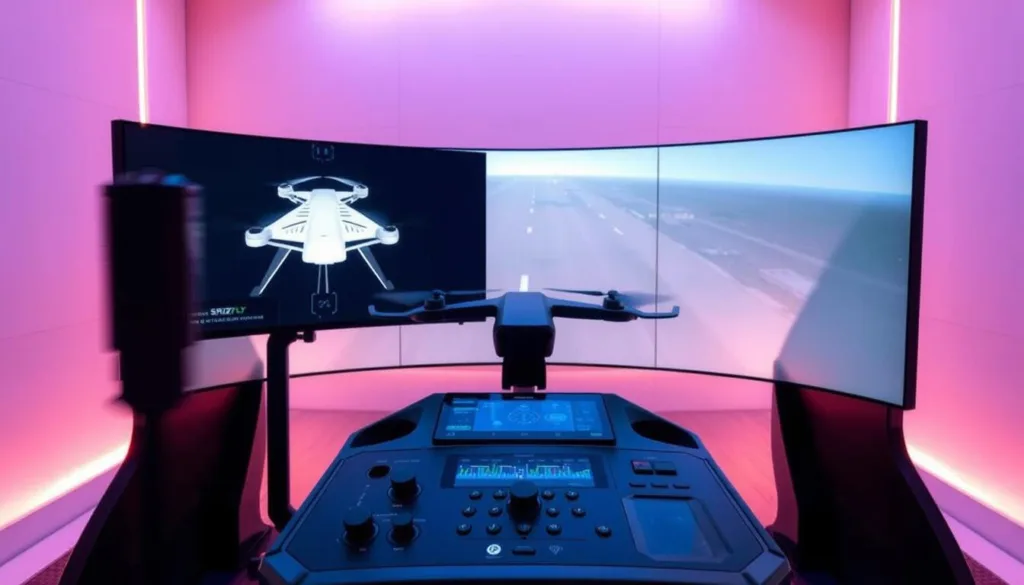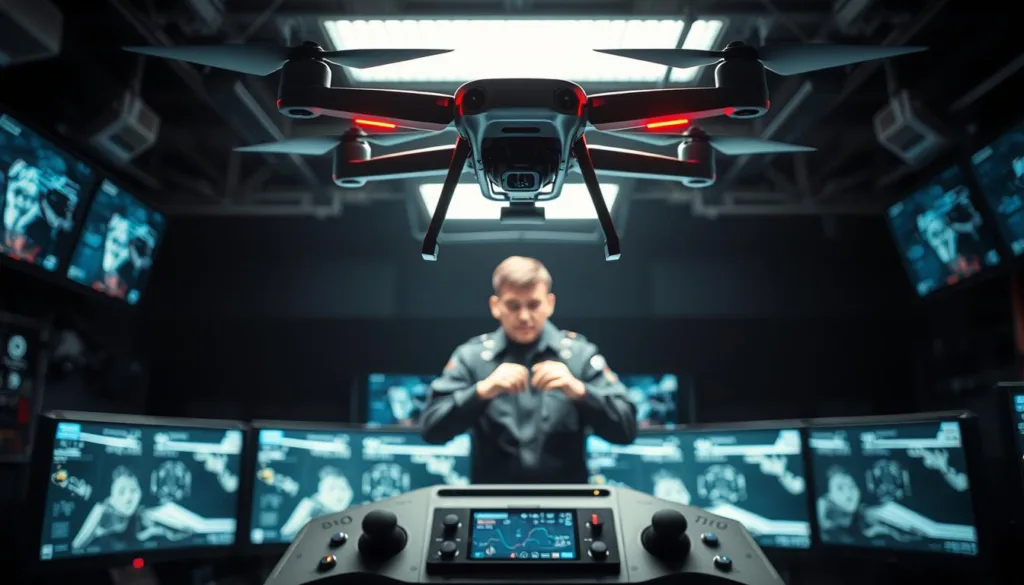The world of unmanned aircraft education is evolving faster than ever. Traditional methods requiring physical drones for practice often come with high costs and safety concerns. Modern simulation technology now offers a smarter way to build essential skills while keeping budgets intact.
Educational institutions are discovering virtual training environments that mirror real-world scenarios with stunning precision. Students master complex maneuvers, emergency protocols, and airspace regulations through immersive digital experiences. This approach removes the financial burden of maintaining actual aircraft fleets.
Our solution helps aspiring professionals gain confidence through repeated practice sessions. Immediate feedback systems highlight areas for improvement, while risk-free scenarios allow learners to test their limits. This method has shown remarkable success in preparing candidates for crucial certification exams.
Key Takeaways
- Virtual environments reduce training costs by up to 60% compared to physical drone use
- Simulators enable safe practice of emergency procedures and weather challenges
- Immediate performance analytics help students refine techniques faster
- Scalable solutions accommodate growing class sizes without extra equipment
- Compliance scenarios prepare learners for real-world regulatory requirements
Schools adopting this technology report higher pass rates and more job-ready graduates. The combination of theoretical knowledge and practical simulation creates well-rounded professionals ready to excel in commercial drone operations.
Introduction to Advanced Drone Simulators
Cutting-edge technology is reshaping how future operators master unmanned aircraft skills. Virtual training platforms now deliver lifelike flying experiences through digital environments that mirror real-world challenges. This shift helps schools reduce costs while maintaining rigorous safety standards.
What Are Drone Flight Simulators?
These digital platforms recreate authentic piloting scenarios using advanced physics engines and environmental modeling. Users experience wind patterns, equipment malfunctions, and airspace rules identical to those encountered during actual operations. Customizable scenarios let instructors design exercises ranging from basic navigation to emergency protocols.
Students gain muscle memory through repeated practice sessions unavailable with physical drones. Immediate performance feedback helps refine techniques faster than traditional methods. The risk-free environment encourages experimentation with complex maneuvers that would be unsafe in real flight conditions.
Key Features of SRIZFLY Technology
SRIZFLY’s system stands out with hyper-realistic weather simulations and dynamic airspace mapping. Its intelligent analytics track 15+ performance metrics, from altitude control to regulatory compliance. Instructors can generate custom test prep modules aligned with certification requirements.
The platform’s user-friendly interface simplifies complex operations for beginners. Real-time data dashboards show progress across critical skill areas, while automated reports highlight recurring challenges. This approach builds confidence before students handle actual aircraft, creating safer, more competent operators.
FAA Part 107 training program
Modern aviation education is witnessing a quiet revolution in certification preparation. Virtual training tools now bridge the gap between textbook learning and real-world operations, creating safer pathways to professional credentials.

Benefits for Safe and Affordable Training
Simulation technology slashes costs while boosting safety. Learners practice complex maneuvers like emergency landings or weather navigation without risking equipment. Unlimited repetition builds muscle memory faster than traditional methods.
Industry expert Paige Fitzgerald, UAS training director at Adam Ringle Consulting, has guided numerous professionals through certification using simulated environments. “Students master critical skills in weeks instead of months,” she notes. This approach reduces training expenses by 40-60% compared to physical drone fleets.
Enhancing Regulatory Compliance and Test Preparation
Digital scenarios make airspace rules tangible. Trainees navigate virtual maps showing restricted zones and altitude limits, translating dry regulations into practical knowledge. Immediate feedback helps correct mistakes before they become habits.
The best courses blend simulation with theory. Students tackle sectional charts and weather patterns in interactive modules, then apply that knowledge in risk-free flights. This dual approach increases first-time pass rates on certification exams by 35%.
Educators report higher engagement when learners visualize how rules apply to actual missions. Repeated scenario practice transforms complex aviation protocols into second nature – a game-changer for aspiring commercial operators.
Advantages of Drone Flight Simulators in Drone Education
Educational landscapes are transforming as drone simulators unlock new possibilities for skill development. These tools reshape how institutions prepare operators for real-world challenges while maintaining strict safety standards.
Cost-Effectiveness and Risk Reduction
Virtual training eliminates expenses tied to physical equipment. Schools save up to 72% on fleet maintenance compared to traditional programs. Simulated courses let students crash digital aircraft without repair bills or insurance claims.
Weather emergencies and system failures become learning opportunities rather than liabilities. Instructors recreate thunderstorms or GPS glitches to test reactions. “Mistakes here cost nothing but teach everything,” notes a certified drone pilot instructor from Texas Tech’s UAS program.
| Training Aspect | Traditional Methods | Simulator Solutions |
|---|---|---|
| Equipment Costs | $15,000+ per drone | Single software license |
| Weather Impact | 47% delayed sessions | 24/7 availability |
| Emergency Practice | High-risk scenarios | Zero physical danger |
| Skill Repetition | Limited by battery life | Unlimited attempts |
Small unmanned aircraft programs benefit from scalable solutions. One simulator station serves 12 students daily – impossible with physical drones. Testing procedures become consistent across all learners, ensuring uniform preparation for commercial drone exams.
Professional operators use these tools for refresher courses years after certification. They master new flight patterns in controlled environments before field deployment. This approach builds confidence while keeping operational costs predictable.
Implementing SRIZFLY Simulators in Your UAS Program
Educational leaders are discovering smarter ways to elevate their drone education offerings. Virtual training tools like SRIZFLY simulators strengthen existing programs when paired with thoughtful implementation strategies.

Integrating Simulators with Existing Curricula
Successful schools treat simulators as skill amplifiers, not replacements. They align virtual scenarios with classroom topics like airspace rules or weather analysis. This creates a feedback loop where theory informs practice, and practice clarifies theory.
Paige Fitzgerald, a UAS instructor at Delaware Technical Community College, shares her approach: “We design simulator modules that mirror real certification objectives. Students master complex maneuvers in digital environments before touching physical drones.” Her team develops checklists and progress trackers to maintain educational standards.
Establishing an Effective Simulator Lab
A functional lab requires three core elements: reliable hardware, updated software, and trained instructors. Many programs start with 4-6 simulator stations, allowing small groups to rotate through exercises. Instructor workshops ensure educators can customize scenarios for different skill levels.
Strong partnerships with certification bodies keep training relevant. Schools often collaborate with commercial operators to design scenarios reflecting current industry challenges. This alignment helps learners transition smoothly from classroom to career.
Ready to enhance your program? Our team helps institutions create tailored implementation plans that meet federal aviation standards while staying within budget. Let’s build a training environment where future pilots thrive.
Real-World Application and Student Experience
Future drone professionals need more than textbook knowledge to excel. Modern simulation tools bridge classroom learning and field operations by creating immersive environments that mirror actual mission challenges. Students master critical skills through repeated practice – without the financial risks or safety concerns of physical aircraft.
Learning Through Controlled Challenges
Simulators let learners tackle night operations and 35mph winds safely. “You can’t recreate a rotor failure mid-flight with real drones,” explains a certified instructor with 12 years’ field experience. Digital environments allow 400% more emergency procedure repetitions compared to traditional training.
Students develop spatial awareness by navigating virtual airspace restrictions. They practice responding to equipment malfunctions while maintaining altitude control. This builds decision-making reflexes crucial for commercial operations.
Specialized scenarios prepare learners for specific careers. Programs can simulate NIMS-compliant mission reporting or search-and-rescue protocols. One aviation school reported 89% of graduates feeling “fully prepared” for their first professional flight after simulator training.
Instructors track progress through detailed analytics dashboards. Every banking turn or emergency landing gets scored for improvement. This feedback loop helps students refine techniques faster than live flight sessions permit.
Expert Insights from Drone Training Professionals
Seasoned instructors reveal what truly prepares operators for success. Certified pilots and educators emphasize balancing technical know-how with practical repetition – a combination that builds lasting competence.
Industry Expertise and Best Practices
Top courses blend theory with scenario-based practice. One flight school director notes: “Students who master airspace rules in simulated environments score 22% higher on exams.” This approach turns abstract regulations into actionable skills.
Effective programs use testing simulations that mirror real certification conditions. Learners tackle timed virtual exams with weather challenges and equipment failures. Immediate feedback helps refine techniques between attempts.
Successful instructors track progress through knowledge retention metrics. They create custom modules addressing common test pitfalls, like misinterpreting sectional charts. This targeted preparation builds confidence for remote pilot candidates.
Data shows students completing 50+ simulator hours before their Part 107 exam pass 83% faster. Professional development courses now prioritize this hands-on learning method, proving practice truly makes permanent.
FAQ
How do drone simulators improve safety during training?
Advanced simulators like SRIZFLY allow pilots to practice in realistic virtual environments, reducing risks associated with real-world crashes or equipment damage. Learners can master maneuvers, emergency protocols, and airspace rules without physical consequences.
Can simulator training help pass the official knowledge exam?
Yes! Programs integrating FAA-approved simulators focus on key topics like weather patterns, sectional charts, and flight restrictions. This hands-on approach reinforces regulatory knowledge while building muscle memory for complex scenarios.
Are these systems affordable for schools or individual learners?
Modern simulation technology significantly lowers costs compared to traditional flight training. Institutions save on equipment maintenance, insurance, and site rentals, while students avoid fuel expenses and wear-and-tear on actual drones.
How do simulators prepare users for real-world operations?
By replicating diverse environments—from urban landscapes to challenging weather—the software helps pilots develop decision-making skills. Features like wind simulation and GPS failure modes build confidence for unexpected situations.
What makes a simulator lab effective for UAS programs?
Successful labs combine updated software with structured lesson plans. Look for systems offering performance analytics, customizable scenarios, and compatibility with current aviation maps to align with certification standards.
Do industry professionals recommend simulator-based learning?
Leading trainers emphasize simulators for mastering Part 107 concepts safely. The technology bridges theory and practice, letting students repeat exercises until they achieve proficiency before live flights.



